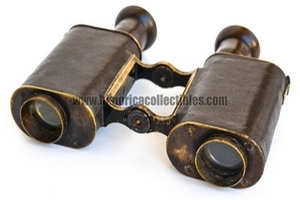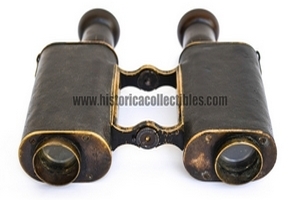Pentaprisma Binoculars 7x23 Moritz Hensoldt & Söhne, Wetzlar, Ebonite Eyepieces, about 1897
Only specimen known and certainly one of the first Binoculars products from M. Hensoldt & Söhne in Wetzlar in 1897 approximately. Made with an aluminum body covered in leather and other parts lacquered brass, the binoculars is equipped with two 23 mm objective lenses, eyecups height of 28 mm and 8 mm lens with 7x magnification. On the left plate is shown, finely hand-engraved "M. Hensoldt and Söhne - Wetzlar" type of brand that was in use since 1896, date of entry into the company of the two sons, Waldemar and Carl, and 1899 last date known brands where hand-engraved are recorded on two monocles and part of binoculars pentaprismatics. On the right plate shows, also finely engraved by hand, information about the model: "Pentraprisma Binocle Patent.".
The special hand carving, present on the plates, were probably carried out personally by Moritz Hensoldt, decisive support is the certainty that Hensoldt was an excellent engraver, who worked from Andreas Wiskemann (designer engineer precision) and from whom thanks to its remarkable ability engraving, prematurely ended the training.
The singular achievement of the two eyepieces, each composed of 2 parts, is performed using a single type of material, ebonite; it is therefore considered that this binoculars was one of the earliest models produced by Moritz Hensoldt in 1897, as none of the models produced are subsequently found to eyecups with these features. We only know 2 monocles and half of pentaprismatic binoculars whose year of production is attributed to 1899, whose eyecups are made of two different materials, but these are knurled.
The binoculars was achieved by adopting the "pentaprism", or an optical prism with five faces, four of which are affected by the path of the light: two act respectively as the input surface and output, two make by reflection planes; the latter are rendered reflective, since the angle of incidence too small (less than the critical angle) prevents to exploit the property of total reflection. Unlike the simple reflection prism, the pentaprism produces an upright image both horizontally (not reversed left-right) and vertical. The authorship of this invention, which saw the application of only very few examples produced by Hensoldt between 1897 and 1903, is due to its founders: Ernst Abbe and Albert König.
This is a great piece of history of optics, unique specimen known, in excellent conditions, through which the view is clear and mechanisms work properly.





